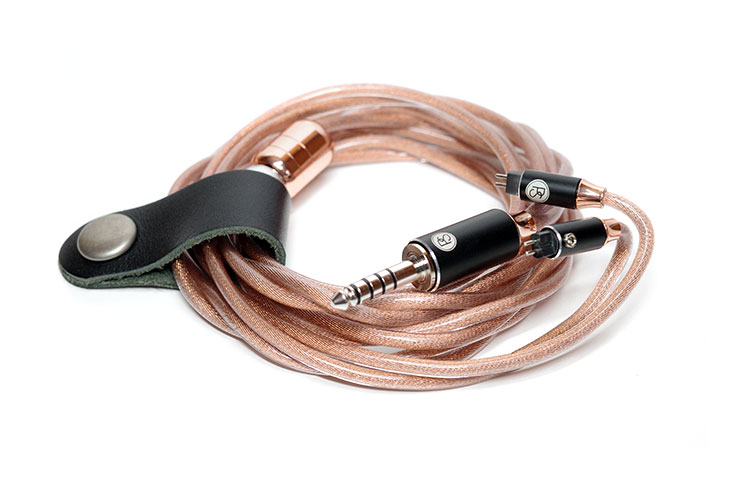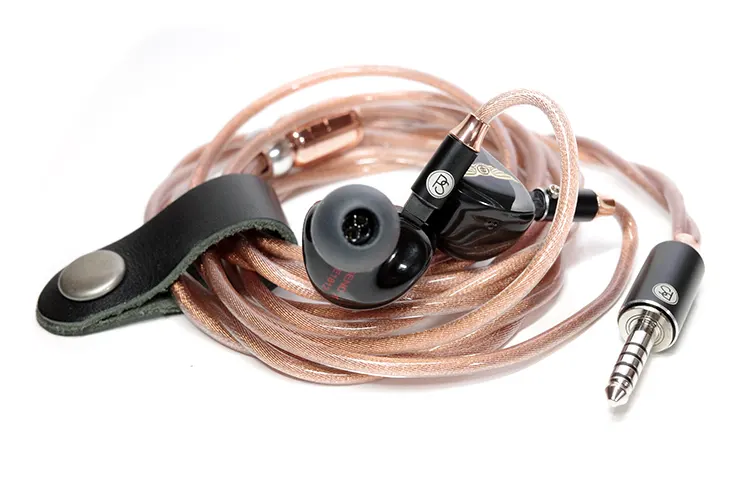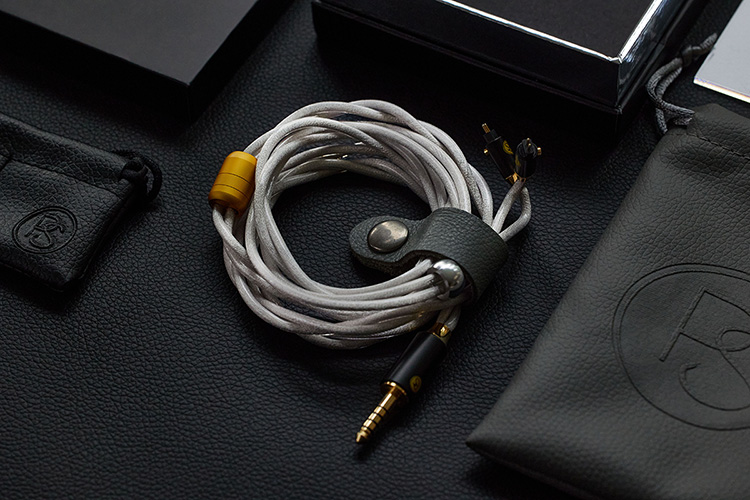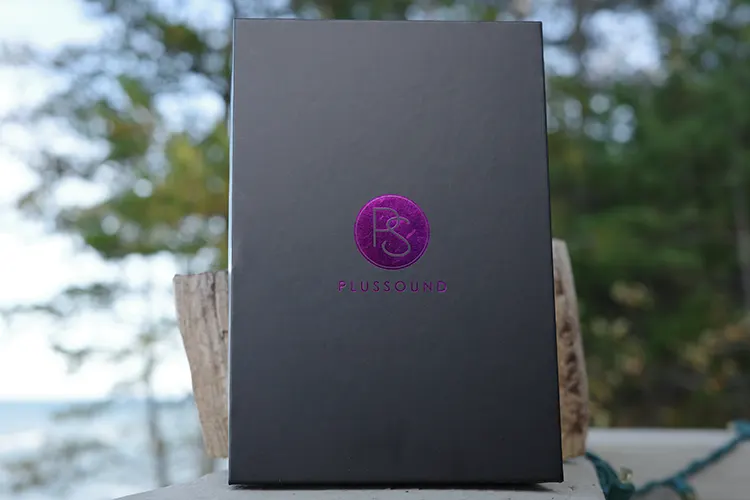Select Comparisons
PLUSSOUND Copper XL
Technical
The Copper XL consists of thick 18AWG UP0OCC pure copper wire with individually enameled coated strands paired with PLUSOUND’s signature Type 6 Litz geometry into a 2-wire configuration.
The 2-wire X cable consists of one 18AWG XL wire per channel intended for IEM use for all purposes.
The Litz group bundle count is raised to 36 (compared to just 6 on 26AWG wire). Purportedly, this eliminates almost most to all electrical resistance, for efficiency, improving the output power. As a result, while the pattern can be used for headphones, this one is designed with IEMs in mind.
Varied dampening cores are also used for the first time. This maintains a round shape for consistent conductivity, that helps to prevent mechanical vibrations which may affect interference and interruptions, while softening the XL wire to make it (almost) as flexible as the smaller gauge wiring.
This should also help to reduce the effects of microphonics from larger cables.
Design
PLUSSOUND cables such as the Silver Plated Copper XL or the Tri-Silver, have a very high level of craftsmanship, with excellent finishing, and a classy feel to them. The Copper XL falls right into that philosophy and is designed to carry on that premium touch.
The two 18AWG copper strands are wound somewhat loosely until they separate at the Y-splitter. I noticed that if you want, you could tighten the braiding simply by twisting the strands together. I did this, and due to the supple nature of the wires, the tighter braid stayed in place.
The individual cores can be seen through the proprietary insulated sheath. For such a large gauge cable, the Copper XL lays quite nicely, and with less tug than one might expect.
Finishing
PLUSSOUND offers many customization options for its cables including the plug type and color, splitter, cable ring, and connectors.
The Copper XL cable sample I have carries a rhodium plug, a large rose gold-colored splitter that comes in the shape of a barrel, a silver cable ring, gold and black connectors, and rose gold sheaths.
The connectors used on the test cable are also rhodium-plated, 2-pin, 0.78mm connectors but PLUSSOUND provides many other variations such as gold-plated and MMCX connections among others.
All of the popular connectivity options are available. Those connectors are designed precisely and have a small rose gold cone that leads into the black barrel or connector. On the inside of the IEM connector, a small “PS” logo can be found.
A (continuing) nice feature of the Copper XL and PLUSSOUND cables in general, is that the left and right-side indicators are shown by a small button that faces the outside of the connector. In the case of our sample, that button is also rhodium, I believe.
Performance
The PLUSSOUND Copper XL adds some richness and warmth, as one might expect from an all-copper cable, but surprisingly to me, the level of detail rose as well.
Better clarity helped with instrument placement and provided a succinctness to the tonality that showed well without becoming dry or analytical—seemingly two antithetical responses when dealing with the previous all-copper cables.
Copper is known to add more color to a signature than silver, seemingly at the expense of detail. That does not seem to be the case with the Copper XL and it provides less color to the sound than the Dual Copper.
The sub-bass and mid-bass ranges from our paired IEMs showed improved clarity, while also reaching deeper. Paired with the warmer, richer signature of the Shanling M6 Pro it did not make the duo too dark or molasses-like, benefitting from the Copper XL’s excellent level of detail.
While the control is tighter, the note weight carries through with a clarity-driven naturalness that follows a copper cable’s main suit. The low-end reach best the Dual Copper, but control of that bass is nearly identical.
There was an excellent grumble down low, with plenty of reverb through the Legend X, lightening the overall tendency for the LX to sound too dark and uncontrolled. The grunt down low did not carry over into the mids, allowing the transition to proceed smoothly.
Resolution in the midrange follows the same presentation pattern as the Silver Plated Copper XL but with a more organic performance. Midrange clarity carries forward with a slight lifting to the presence region.
This elevation carries over into the upper region, allowing for a smooth transition with the grace for which copper cables are known. The Dual Copper provides the same pattern but with a bit less smoothness to it.
PLUSSOUND Silver Plated Copper XL
Technical
When Joshua reviewed the PLUSSOUND Silver Plated Copper XL he called it, “a very good addition to one’s cable collection if you are looking to provide extra color and detail to the mid-bass and mid-range of your high-end IEMs.”
Carrying much of the same construction and technicalities of the Copper XL (and now Dual Copper), the Silver Plated Copper XL changes the wire choice to UP-OCC silver-plated copper as its base material. Silver is used as opposed to Palladium coating.
The geometry is similar to the Copper XL, which means a Type 6×6 Litz, 18AWG gauge 2-wire geometry using a 36-bundle implementation.
With 18AWG gauging per XL wire, the Silver Plated Copper XL is a thick cable. However, PLUSSOUND has done exceptionally well to keep the cable as flexible and as supple as possible by using their very own propriety outer insulation for the cable’s jacket.
While not as pliant as the Dual Copper, it makes me realize how a large-sized cable need not be as stiff as a coat hanger.
Design
The Silver Plated Copper XL comes with exceptional build quality, that is no different from the company philosophies.
The braided wire, finished with a threadlike texture, has a sparkly silver color, representing its silver-plating properties. Each wire has sufficient tension in the braiding design so there are no unwanted gaps or slacks in the cable.
Built very similarly to the Dual Copper, but with different accents, the Silver Plated Copper XL is stunning at which to look, regardless.
Performance
The Silver Plated Copper XL colors the sound by further enhancing the overall resolution and clarity of the mid-range and creating more depth and slam to the bass frequencies. It should be noted that staging and treble impacts do vary depending on the pair-up.
A noticeable impact was had on the sub and mid-bass gaining more depth, extension, and elasticity. The sub-bass digs deeper and the reverb becomes more tactile with the mid-bass receiving a noticeable boost whilst gaining more slam and control.
This differs from the Dual Copper, which promoted slightly less sub-bass, yes, but more mid-bass.
The mid-bass punch feels “elastic” in the sense that its dynamic range and control improve. The bass texture within both the sub and mid-bass improves resulting in better overall resolution and quality.
Similar to the Dual Copper regarding the added dynamic control and range. This epitomizes the family resemblance to a “T.”
The lower and center mid-range move forward whereas the upper mid-range positioning remains unchanged relative to the IEM’s (Twin Pulse) original setup.
The lower and center mid-range is also delivered with added volume and weight to each note which is a result of the additional mid-bass presence. The Dual Copper promoted slightly more warmth and richness, with slightly less vibrancy to the tonality than the Silver Plated and slightly thinner note quality.
The resolution of the mid-range improves and there is a step up in overall sound quality being delivered as the Silver Plated Copper XL can tease out the finer details.
The Dual Copper clearly shows it belongs in the mix by providing a lilt to the character, while the Silver Plated Copper goes for more resolution.
Eletech Socrates
Materials & Geometry
The Socrates is one of Eletech’s midrange IEM cables but with a bigger 24AWG wire made from monocrystal 7N OCC Copper.
A Kevlar-infused strand at the core helps keep stability and adds to its “Maximus Efficiency Strand Geometry.”
Also cryogenically treated like the Dual Copper, this purports to align the strands so that the transmission of electrical signals is faster with less distortion and low electrical resistance.
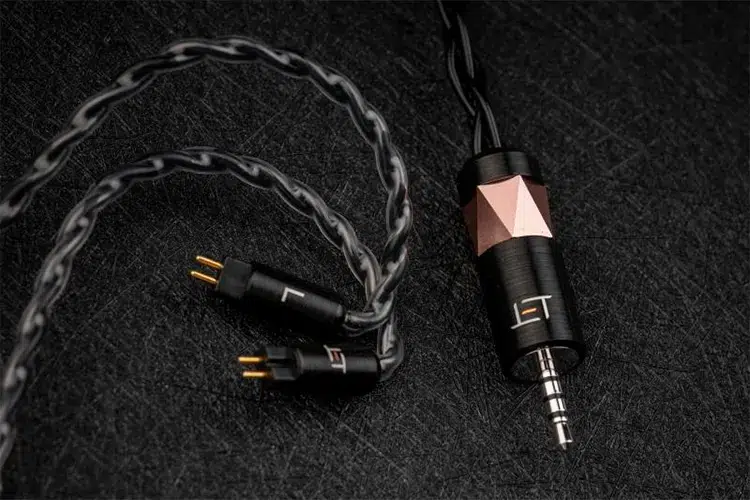
Design
Stiffer in feel than the Dual Copper, the black plastic sheathing looks less luxurious, too. Curved ear hooks are shrink sheaths, helping to keep the cable in place but the bend of the Dual Copper helps alleviate this difference.
The black and rose gold Y-splitter has no cable cinch and looks a bit less upscale as well. I do appreciate the “L” and “R” on the 2-pin jacks, though. A gold 4.4mm balanced termination counters the rose gold and black coloring scheme, but when plugged in, you cannot see it anyway.
While the Socrates is quite the looker, the Dual Copper has a more mainstream, which is not always a bad thing.
Performance
Copper traditionally is known for good bass extension and a darker, richer signature. The Socrates is no different.
Providing very good reach in the sub-bass region, and with good control. That bass extension carries over into the mid-bass, giving a bit more grunt to the low end than the Dual Copper, even though both emphasize this region. The definition is better in the Dual Copper, though.
The midrange comes across as rich and melodic, with slightly less detail than the Dual Copper. This is a very organic sound, but it carries thickness over complete naturalness. Vocals sound sumptuous on the Socrates whereas on the Dual Copper, they sound more accurate and nuanced.
Once we hit the top end, the Socrates falls behind the Dual Copper with less punch and sparkle due to the darker signature. Where the Dual Copper carries clarity and a bit of sparkle up top (less than the Copper XL, though), the Socrates carries the note thickness into the nether region.
This will come down to whether the listener prefers a darker, thicker note weight that carries an organic signature or one that carries the best of bass notes in-depth and quality while sounding more detailed and accurate.
The difference here is stark: more detail and accuracy for the Dual Copper, as opposed to the dark, richness of the Socrates.
My Verdict
The PLUSSOUND Dual Copper carries a lightness to the sound, which allows the air between notes to fill in without a thinning effect and provides a very good addition to the overall characteristics of my paired IEM’s performance instead of subtracting from any one thing.
Tight, controlled bass allows the sumptuous midrange to carry forth very good vocal details and midrange instrumentation.
The top end is stretched enough to be additive as well, without stretching so far as to become sibilant or overreaching. The balance is a tough one, and the Dual Copper follows through positively.
Providing a distinct ‘copper sound’ is no small challenge, and the last two iterations I have reviewed from PLUSSOUND show that innovation is a good thing, the Dual Copper is no exception.
PLUSSOUND Dual Copper Technical Specifications
- Wires: UP-OCC
- Materials: Copper + PPC
- Size: 26AWG
- Design: Modified Type 6 Litz
- Insulation: Proprietary PS
- Cores: New Dual Hybrid (Wire + Dampening)


